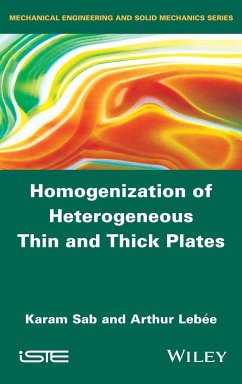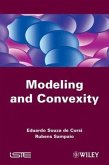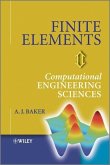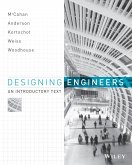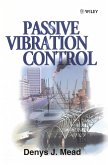- Gebundenes Buch
- Merkliste
- Auf die Merkliste
- Bewerten Bewerten
- Teilen
- Produkt teilen
- Produkterinnerung
- Produkterinnerung
This book gives new insight on plate models in the linear elasticity framework tacking into account heterogeneities and thickness effects. It is targeted to graduate students how want to discover plate models but deals also with latest developments on higher order models. Plates models are both an ancient matter and a still active field of research. First attempts date back to the beginning of the 19th century with Sophie Germain. Very efficient models have been suggested for homogeneous and isotropic plates by Love (1888) for thin plates and Reissner (1945) for thick plates. However, the…mehr
Andere Kunden interessierten sich auch für
![Modeling and Convexity Modeling and Convexity]() Eduardo Souza de CursiModeling and Convexity268,99 €
Eduardo Souza de CursiModeling and Convexity268,99 €![Introduction to Finite Element Analysis Introduction to Finite Element Analysis]() Barna SzabóIntroduction to Finite Element Analysis141,99 €
Barna SzabóIntroduction to Finite Element Analysis141,99 €![Finite Elements Finite Elements]() A. J. BakerFinite Elements126,99 €
A. J. BakerFinite Elements126,99 €![Analysis, Design and Optimization of Composite Structures Analysis, Design and Optimization of Composite Structures]() Alexander L. KalamkarovAnalysis, Design and Optimization of Composite Structures353,99 €
Alexander L. KalamkarovAnalysis, Design and Optimization of Composite Structures353,99 €![Uncertainty and Optimization in Structural Mechanics Uncertainty and Optimization in Structural Mechanics]() Abdelkhalak El HamiUncertainty and Optimization in Structural Mechanics180,99 €
Abdelkhalak El HamiUncertainty and Optimization in Structural Mechanics180,99 €![Designing Engineers Designing Engineers]() Susan McCahanDesigning Engineers178,99 €
Susan McCahanDesigning Engineers178,99 €![Passive Vibration Control Passive Vibration Control]() Denys J. MeadPassive Vibration Control792,99 €
Denys J. MeadPassive Vibration Control792,99 €-
-
-
This book gives new insight on plate models in the linear elasticity framework tacking into account heterogeneities and thickness effects. It is targeted to graduate students how want to discover plate models but deals also with latest developments on higher order models. Plates models are both an ancient matter and a still active field of research. First attempts date back to the beginning of the 19th century with Sophie Germain. Very efficient models have been suggested for homogeneous and isotropic plates by Love (1888) for thin plates and Reissner (1945) for thick plates. However, the extension of such models to more general situations --such as laminated plates with highly anisotropic layers-- and periodic plates --such as honeycomb sandwich panels-- raised a number of difficulties. An extremely wide literature is accessible on these questions, from very simplistic approaches, which are very limited, to extremely elaborated mathematical theories, which might refrain the beginner. Starting from continuum mechanics concepts, this book introduces plate models of progressive complexity and tackles rigorously the influence of the thickness of the plate and of the heterogeneity. It provides also latest research results. The major part of the book deals with a new theory which is the extension to general situations of the well established Reissner-Mindlin theory. These results are completely new and give a new insight to some aspects of plate theories which were controversial till recently.
Produktdetails
- Produktdetails
- Verlag: Wiley & Sons
- 1. Auflage
- Seitenzahl: 294
- Erscheinungstermin: 9. November 2015
- Englisch
- Abmessung: 240mm x 161mm x 22mm
- Gewicht: 648g
- ISBN-13: 9781848216525
- ISBN-10: 1848216521
- Artikelnr.: 40054886
- Verlag: Wiley & Sons
- 1. Auflage
- Seitenzahl: 294
- Erscheinungstermin: 9. November 2015
- Englisch
- Abmessung: 240mm x 161mm x 22mm
- Gewicht: 648g
- ISBN-13: 9781848216525
- ISBN-10: 1848216521
- Artikelnr.: 40054886
Karam Sab is a Professor and head of Laboratoire Navier, which is a joint research unit between Ecole des Ponts ParisTech, IFSTTAR and CNRS. The research concerns the mechanics and physics of materials and structures, in geotechnics, and their applications to in particular civil engineering and petroleum geophysics. His main research topics concern the homogenization of heterogeneous materials and plates: Random materials, Representative Volume Element (RVE), Simulation, Higher order models (Cosserat), Multi-layered plates, Periodic plates, Random plates, Shear effects. The applications concern solid foams, aggregate composites, bituminous materials, cementitious materials, masonry walls, reinforced structures, functionally graded materials, sandwich plates, and space frames. Arthur Lebee is Researcher at Laboratoire Navier, which is a joint research unit between Ecole des Ponts ParisTech, IFSTTAR and CNRS. The research concerns the mechanics and physics of materials and structures, in geotechnics, and their applications to in particular civil engineering and petroleum geophysics.
Introduction xi Chapter 1. Linear Elasticity 1 1.1. Notations 1 1.2. Stress
3 1.3. Linearized strains 6 1.4. Small perturbations 8 1.5. Linear
elasticity 8 1.6. Boundary value problem in linear elasticity 10 1.7.
Variational formulations. 11 1.7.1. Compatible strains and stresses 11
1.7.2. Principle of minimum of potential energy 13 1.7.3. Principle of
minimum of complementary energy 14 1.7.4. Two-energy principle 15 1.8.
Anisotropy 15 1.8.1. Voigt notations 15 1.8.2. Material symmetries 17
1.8.3. Orthotropy 20 1.8.4. Transverse isotropy 22 1.8.5. Isotropy 23 Part
1. Thin Laminated Plates 27 Chapter 2. A Static Approach for Deriving the
Kirchhoff-Love Model for Thin Homogeneous Plates 29 2.1. The 3D problem 29
2.2. Thin plate subjected to in-plane loading 32 2.2.1. The plane-stress 2D
elasticity problem 33 2.2.2. Application of the two-energy principle 34
2.2.3. In-plane surfacic forces on dOmega ± 336 2.2.4. Dirichlet conditions
on the lateral boundary of the plate 38 2.3. Thin plate subjected to
out-of-plane loading 40 2.3.1. The Kirchhoff-Love plate model 41 2.3.2.
Application of the two-energy principle 47 Chapter 3. The Kirchhoff-Love
Model for Thin Laminated Plates 53 3.1. The 3D problem 53 3.2. Deriving the
Kirchhoff-Love plate model 55 3.2.1. The generalized plate stresses 55
3.2.2. Static variational formulation of the Kirchhoff-Love plate model 56
3.2.3. Direct formulation of the Kirchhoff-Love plate model 58 3.3.
Application of the two-energy principle 59 Part 2. Thick Laminated Plates
65 Chapter 4. Thick Homogeneous Plate Subjected to Out-of-Plane Loading 67
4.1. The 3D problem 67 4.2. The Reissner-Mindlin plate model. 69 4.2.1. The
3D stress distribution in the Kirchhoff-Love plate model 69 4.2.2.
Formulation of the Reissner-Mindlin plate model 71 4.2.3. Characterization
of the Reissner-Mindlin stress solution 72 4.2.4. The Reissner-Mindlin
kinematics 73 4.2.5. Derivation of the direct formulation of the
Reissner-Mindlin plate model 74 4.2.6. The relations between generalized
plate displacements and 3D displacements 76 Chapter 5. Thick Symmetric
Laminated Plate Subjected to Out-of-Plane Loading 81 5.1. Notations 81 5.2.
The 3D problem 82 5.3. The generalized Reissner plate model 85 5.3.1. The
3D stress distribution in the Kirchhoff-Love plate model 85 5.3.2.
Formulation of the generalized Reissner plate model 90 5.3.3. The subspaces
of generalized stresses 91 5.3.4. The generalized Reissner equilibrium
equations 95 5.3.5. Characterization of the generalized Reissner stress
solution 97 5.3.6. The generalized Reissner kinematics 98 5.3.7. Derivation
of the direct formulation of the generalized Reissner plate model 100
5.3.8. The relationships between generalized plate displacements and 3D
displacements 102 5.4. Derivation of the Bending-Gradient plate model 106
5.5. The case of isotropic homogeneous plates 109 5.6. Bending-Gradient or
Reissner-Mindlin plate model? 111 5.6.1. When does the Bending-Gradient
model degenerate into the Reissner-Mindlin's model? 112 5.6.2. The shear
compliance projection of the Bending-Gradient model onto the
Reissner-Mindlin model 113 5.6.3. The shear stiffness projection of the
Bending-Gradient model onto the Reissner-Mindlin model 115 5.6.4. The
cylindrical bending projection of the Bending-Gradient model onto the
Reissner-Mindlin model 116 Chapter 6. The Bending-Gradient Theory 117 6.1.
The 3D problem 117 6.2. The Bending-Gradient problem 119 6.2.1. Generalized
stresses 119 6.2.2. Equilibrium equations 121 6.2.3. Generalized
displacements 122 6.2.4. Constitutive equations 122 6.2.5. Summary of the
Bending-Gradient plate model 123 6.2.6. Field localization 123 6.3.
Variational formulations 125 6.3.1. Minimum of the potential energy 126
6.3.2. Minimum of the complementary energy 127 6.4. Boundary conditions 128
6.4.1. Free boundary condition 129 6.4.2. Simple support boundary condition
130 6.4.3. Clamped boundary condition 131 6.5. Voigt notations 131 6.5.1.
In-plane variables and constitutive equations 131 6.5.2. Generalized shear
variables and constitutive equations 132 6.5.3. Field localization 135 6.6.
Symmetries 136 6.6.1. Transformation formulas 136 6.6.2. Orthotropy 139
6.6.3. pi/2 invariance 140 6.6.4. Square symmetry 140 6.6.5. Isotropy 140
6.6.6. The remarkable case of functionally graded materials 142 Chapter 7.
Application to Laminates 145 7.1. Laminated plate configuration 145 7.2.
Localization fields 146 7.2.1. In-plane stress unit distributions (bending
stress) 147 7.2.2. Transverse shear unit distributions (generalized shear
stress) 148 7.3. Distance between the Reissner-Mindlin and the
Bending-Gradient model 149 7.4. Cylindrical bending 150 7.4.1. Closed-form
solution for the Bending-Gradient model 152 7.4.2. Comparison of field
distributions 155 7.4.3. Empirical error estimates and convergence rate 160
7.4.4. Influence of the bending direction 161 7.5. Conclusion 163 Part 3
Periodic Plates 167 Chapter 8. Thin Periodic Plates 169 8.1. The 3D problem
169 8.2. The homogenized plate problem 173 8.3. Determination of the
homogenized plate elastic stiffness tensors 174 8.4. A first justification:
the asymptotic effective elastic properties of periodic plates 181 8.5.
Effect of symmetries 184 8.5.1. Symmetric periodic plate 185 8.5.2.
Material symmetry of the homogenized plate 186 8.5.3. Important special
cases 187 8.5.4. Rectangular parallelepipedic unit cell 189 8.6. Second
justification: the asymptotic expansion method 194 Chapter 9. Thick
Periodic Plates 205 9.1. The 3D problem 206 9.2. The asymptotic solution
208 9.3. The Bending-Gradient homogenization scheme 209 9.3.1. Motivation
and descrition of the approach 210 9.3.2. Introduction of corrective terms
to the asymptotic solution 210 9.3.3. Identification of the localization
tensors 212 9.3.4. Identification of the Bending-Gradient compliance tensor
214 Chapter 10. Application to Cellular Sandwich Panels 219 10.1.
Introduction 219 10.2. Questions raised by sandwich panel shear force
stiffness 220 10.2.1. The case of homogeneous cores 221 10.2.2. The case of
cellular cores 223 10.3. The membrane and bending behavior of sandwich
panels 225 10.3.1. The case of homogeneous cores 225 10.3.2. The case of
cellular cores 226 10.4. The transverse shear behavior of sandwich panels
229 10.4.1. The case of homogeneous cores 229 10.4.2. A direct
homogenization scheme for cellular sandwich panel shear force stiffness 230
10.4.3. Discussion 232 10.5. Application to a sandwich panel including
Miura-ori 235 10.5.1. Folded cores 236 10.5.2. Description of the sandwich
panel including the folded core 237 10.5.3. Symmetries of Miura-ori 238
10.5.4. Implementation 239 10.5.5. Results 241 10.5.6. Discussion on shear
force stiffness 250 10.5.7. Consequence of skins distortion 255 10.6.
Conclusion 257 Chapter 11. Application to Space Frames 259 11.1.
Introduction 259 11.2. Homogenization of a periodic space frame as a thick
plate 261 11.2.1. Homogenization scheme 261 11.3. Homogenization of a
square lattice as a Bending-Gradient plate 268 11.3.1. The unit-cell 268
11.3.2. Kirchhoff-Love auxiliary problem 269 11.3.3. Bending-Gradient and
Reissner-Mindlin auxiliary problems 270 11.3.4. Difference between
Reissner-Mindlin and Bending-Gradient constitutive equation 273 11.4.
Cylindrical bending of a square beam lattice 274 11.4.1. Lattice at 0° 274
11.4.2. Lattice at 45° 276 11.5. Discussion 282 11.6. Conclusion 283
Bibliography 285 Index 293
3 1.3. Linearized strains 6 1.4. Small perturbations 8 1.5. Linear
elasticity 8 1.6. Boundary value problem in linear elasticity 10 1.7.
Variational formulations. 11 1.7.1. Compatible strains and stresses 11
1.7.2. Principle of minimum of potential energy 13 1.7.3. Principle of
minimum of complementary energy 14 1.7.4. Two-energy principle 15 1.8.
Anisotropy 15 1.8.1. Voigt notations 15 1.8.2. Material symmetries 17
1.8.3. Orthotropy 20 1.8.4. Transverse isotropy 22 1.8.5. Isotropy 23 Part
1. Thin Laminated Plates 27 Chapter 2. A Static Approach for Deriving the
Kirchhoff-Love Model for Thin Homogeneous Plates 29 2.1. The 3D problem 29
2.2. Thin plate subjected to in-plane loading 32 2.2.1. The plane-stress 2D
elasticity problem 33 2.2.2. Application of the two-energy principle 34
2.2.3. In-plane surfacic forces on dOmega ± 336 2.2.4. Dirichlet conditions
on the lateral boundary of the plate 38 2.3. Thin plate subjected to
out-of-plane loading 40 2.3.1. The Kirchhoff-Love plate model 41 2.3.2.
Application of the two-energy principle 47 Chapter 3. The Kirchhoff-Love
Model for Thin Laminated Plates 53 3.1. The 3D problem 53 3.2. Deriving the
Kirchhoff-Love plate model 55 3.2.1. The generalized plate stresses 55
3.2.2. Static variational formulation of the Kirchhoff-Love plate model 56
3.2.3. Direct formulation of the Kirchhoff-Love plate model 58 3.3.
Application of the two-energy principle 59 Part 2. Thick Laminated Plates
65 Chapter 4. Thick Homogeneous Plate Subjected to Out-of-Plane Loading 67
4.1. The 3D problem 67 4.2. The Reissner-Mindlin plate model. 69 4.2.1. The
3D stress distribution in the Kirchhoff-Love plate model 69 4.2.2.
Formulation of the Reissner-Mindlin plate model 71 4.2.3. Characterization
of the Reissner-Mindlin stress solution 72 4.2.4. The Reissner-Mindlin
kinematics 73 4.2.5. Derivation of the direct formulation of the
Reissner-Mindlin plate model 74 4.2.6. The relations between generalized
plate displacements and 3D displacements 76 Chapter 5. Thick Symmetric
Laminated Plate Subjected to Out-of-Plane Loading 81 5.1. Notations 81 5.2.
The 3D problem 82 5.3. The generalized Reissner plate model 85 5.3.1. The
3D stress distribution in the Kirchhoff-Love plate model 85 5.3.2.
Formulation of the generalized Reissner plate model 90 5.3.3. The subspaces
of generalized stresses 91 5.3.4. The generalized Reissner equilibrium
equations 95 5.3.5. Characterization of the generalized Reissner stress
solution 97 5.3.6. The generalized Reissner kinematics 98 5.3.7. Derivation
of the direct formulation of the generalized Reissner plate model 100
5.3.8. The relationships between generalized plate displacements and 3D
displacements 102 5.4. Derivation of the Bending-Gradient plate model 106
5.5. The case of isotropic homogeneous plates 109 5.6. Bending-Gradient or
Reissner-Mindlin plate model? 111 5.6.1. When does the Bending-Gradient
model degenerate into the Reissner-Mindlin's model? 112 5.6.2. The shear
compliance projection of the Bending-Gradient model onto the
Reissner-Mindlin model 113 5.6.3. The shear stiffness projection of the
Bending-Gradient model onto the Reissner-Mindlin model 115 5.6.4. The
cylindrical bending projection of the Bending-Gradient model onto the
Reissner-Mindlin model 116 Chapter 6. The Bending-Gradient Theory 117 6.1.
The 3D problem 117 6.2. The Bending-Gradient problem 119 6.2.1. Generalized
stresses 119 6.2.2. Equilibrium equations 121 6.2.3. Generalized
displacements 122 6.2.4. Constitutive equations 122 6.2.5. Summary of the
Bending-Gradient plate model 123 6.2.6. Field localization 123 6.3.
Variational formulations 125 6.3.1. Minimum of the potential energy 126
6.3.2. Minimum of the complementary energy 127 6.4. Boundary conditions 128
6.4.1. Free boundary condition 129 6.4.2. Simple support boundary condition
130 6.4.3. Clamped boundary condition 131 6.5. Voigt notations 131 6.5.1.
In-plane variables and constitutive equations 131 6.5.2. Generalized shear
variables and constitutive equations 132 6.5.3. Field localization 135 6.6.
Symmetries 136 6.6.1. Transformation formulas 136 6.6.2. Orthotropy 139
6.6.3. pi/2 invariance 140 6.6.4. Square symmetry 140 6.6.5. Isotropy 140
6.6.6. The remarkable case of functionally graded materials 142 Chapter 7.
Application to Laminates 145 7.1. Laminated plate configuration 145 7.2.
Localization fields 146 7.2.1. In-plane stress unit distributions (bending
stress) 147 7.2.2. Transverse shear unit distributions (generalized shear
stress) 148 7.3. Distance between the Reissner-Mindlin and the
Bending-Gradient model 149 7.4. Cylindrical bending 150 7.4.1. Closed-form
solution for the Bending-Gradient model 152 7.4.2. Comparison of field
distributions 155 7.4.3. Empirical error estimates and convergence rate 160
7.4.4. Influence of the bending direction 161 7.5. Conclusion 163 Part 3
Periodic Plates 167 Chapter 8. Thin Periodic Plates 169 8.1. The 3D problem
169 8.2. The homogenized plate problem 173 8.3. Determination of the
homogenized plate elastic stiffness tensors 174 8.4. A first justification:
the asymptotic effective elastic properties of periodic plates 181 8.5.
Effect of symmetries 184 8.5.1. Symmetric periodic plate 185 8.5.2.
Material symmetry of the homogenized plate 186 8.5.3. Important special
cases 187 8.5.4. Rectangular parallelepipedic unit cell 189 8.6. Second
justification: the asymptotic expansion method 194 Chapter 9. Thick
Periodic Plates 205 9.1. The 3D problem 206 9.2. The asymptotic solution
208 9.3. The Bending-Gradient homogenization scheme 209 9.3.1. Motivation
and descrition of the approach 210 9.3.2. Introduction of corrective terms
to the asymptotic solution 210 9.3.3. Identification of the localization
tensors 212 9.3.4. Identification of the Bending-Gradient compliance tensor
214 Chapter 10. Application to Cellular Sandwich Panels 219 10.1.
Introduction 219 10.2. Questions raised by sandwich panel shear force
stiffness 220 10.2.1. The case of homogeneous cores 221 10.2.2. The case of
cellular cores 223 10.3. The membrane and bending behavior of sandwich
panels 225 10.3.1. The case of homogeneous cores 225 10.3.2. The case of
cellular cores 226 10.4. The transverse shear behavior of sandwich panels
229 10.4.1. The case of homogeneous cores 229 10.4.2. A direct
homogenization scheme for cellular sandwich panel shear force stiffness 230
10.4.3. Discussion 232 10.5. Application to a sandwich panel including
Miura-ori 235 10.5.1. Folded cores 236 10.5.2. Description of the sandwich
panel including the folded core 237 10.5.3. Symmetries of Miura-ori 238
10.5.4. Implementation 239 10.5.5. Results 241 10.5.6. Discussion on shear
force stiffness 250 10.5.7. Consequence of skins distortion 255 10.6.
Conclusion 257 Chapter 11. Application to Space Frames 259 11.1.
Introduction 259 11.2. Homogenization of a periodic space frame as a thick
plate 261 11.2.1. Homogenization scheme 261 11.3. Homogenization of a
square lattice as a Bending-Gradient plate 268 11.3.1. The unit-cell 268
11.3.2. Kirchhoff-Love auxiliary problem 269 11.3.3. Bending-Gradient and
Reissner-Mindlin auxiliary problems 270 11.3.4. Difference between
Reissner-Mindlin and Bending-Gradient constitutive equation 273 11.4.
Cylindrical bending of a square beam lattice 274 11.4.1. Lattice at 0° 274
11.4.2. Lattice at 45° 276 11.5. Discussion 282 11.6. Conclusion 283
Bibliography 285 Index 293
Introduction xi Chapter 1. Linear Elasticity 1 1.1. Notations 1 1.2. Stress
3 1.3. Linearized strains 6 1.4. Small perturbations 8 1.5. Linear
elasticity 8 1.6. Boundary value problem in linear elasticity 10 1.7.
Variational formulations. 11 1.7.1. Compatible strains and stresses 11
1.7.2. Principle of minimum of potential energy 13 1.7.3. Principle of
minimum of complementary energy 14 1.7.4. Two-energy principle 15 1.8.
Anisotropy 15 1.8.1. Voigt notations 15 1.8.2. Material symmetries 17
1.8.3. Orthotropy 20 1.8.4. Transverse isotropy 22 1.8.5. Isotropy 23 Part
1. Thin Laminated Plates 27 Chapter 2. A Static Approach for Deriving the
Kirchhoff-Love Model for Thin Homogeneous Plates 29 2.1. The 3D problem 29
2.2. Thin plate subjected to in-plane loading 32 2.2.1. The plane-stress 2D
elasticity problem 33 2.2.2. Application of the two-energy principle 34
2.2.3. In-plane surfacic forces on dOmega ± 336 2.2.4. Dirichlet conditions
on the lateral boundary of the plate 38 2.3. Thin plate subjected to
out-of-plane loading 40 2.3.1. The Kirchhoff-Love plate model 41 2.3.2.
Application of the two-energy principle 47 Chapter 3. The Kirchhoff-Love
Model for Thin Laminated Plates 53 3.1. The 3D problem 53 3.2. Deriving the
Kirchhoff-Love plate model 55 3.2.1. The generalized plate stresses 55
3.2.2. Static variational formulation of the Kirchhoff-Love plate model 56
3.2.3. Direct formulation of the Kirchhoff-Love plate model 58 3.3.
Application of the two-energy principle 59 Part 2. Thick Laminated Plates
65 Chapter 4. Thick Homogeneous Plate Subjected to Out-of-Plane Loading 67
4.1. The 3D problem 67 4.2. The Reissner-Mindlin plate model. 69 4.2.1. The
3D stress distribution in the Kirchhoff-Love plate model 69 4.2.2.
Formulation of the Reissner-Mindlin plate model 71 4.2.3. Characterization
of the Reissner-Mindlin stress solution 72 4.2.4. The Reissner-Mindlin
kinematics 73 4.2.5. Derivation of the direct formulation of the
Reissner-Mindlin plate model 74 4.2.6. The relations between generalized
plate displacements and 3D displacements 76 Chapter 5. Thick Symmetric
Laminated Plate Subjected to Out-of-Plane Loading 81 5.1. Notations 81 5.2.
The 3D problem 82 5.3. The generalized Reissner plate model 85 5.3.1. The
3D stress distribution in the Kirchhoff-Love plate model 85 5.3.2.
Formulation of the generalized Reissner plate model 90 5.3.3. The subspaces
of generalized stresses 91 5.3.4. The generalized Reissner equilibrium
equations 95 5.3.5. Characterization of the generalized Reissner stress
solution 97 5.3.6. The generalized Reissner kinematics 98 5.3.7. Derivation
of the direct formulation of the generalized Reissner plate model 100
5.3.8. The relationships between generalized plate displacements and 3D
displacements 102 5.4. Derivation of the Bending-Gradient plate model 106
5.5. The case of isotropic homogeneous plates 109 5.6. Bending-Gradient or
Reissner-Mindlin plate model? 111 5.6.1. When does the Bending-Gradient
model degenerate into the Reissner-Mindlin's model? 112 5.6.2. The shear
compliance projection of the Bending-Gradient model onto the
Reissner-Mindlin model 113 5.6.3. The shear stiffness projection of the
Bending-Gradient model onto the Reissner-Mindlin model 115 5.6.4. The
cylindrical bending projection of the Bending-Gradient model onto the
Reissner-Mindlin model 116 Chapter 6. The Bending-Gradient Theory 117 6.1.
The 3D problem 117 6.2. The Bending-Gradient problem 119 6.2.1. Generalized
stresses 119 6.2.2. Equilibrium equations 121 6.2.3. Generalized
displacements 122 6.2.4. Constitutive equations 122 6.2.5. Summary of the
Bending-Gradient plate model 123 6.2.6. Field localization 123 6.3.
Variational formulations 125 6.3.1. Minimum of the potential energy 126
6.3.2. Minimum of the complementary energy 127 6.4. Boundary conditions 128
6.4.1. Free boundary condition 129 6.4.2. Simple support boundary condition
130 6.4.3. Clamped boundary condition 131 6.5. Voigt notations 131 6.5.1.
In-plane variables and constitutive equations 131 6.5.2. Generalized shear
variables and constitutive equations 132 6.5.3. Field localization 135 6.6.
Symmetries 136 6.6.1. Transformation formulas 136 6.6.2. Orthotropy 139
6.6.3. pi/2 invariance 140 6.6.4. Square symmetry 140 6.6.5. Isotropy 140
6.6.6. The remarkable case of functionally graded materials 142 Chapter 7.
Application to Laminates 145 7.1. Laminated plate configuration 145 7.2.
Localization fields 146 7.2.1. In-plane stress unit distributions (bending
stress) 147 7.2.2. Transverse shear unit distributions (generalized shear
stress) 148 7.3. Distance between the Reissner-Mindlin and the
Bending-Gradient model 149 7.4. Cylindrical bending 150 7.4.1. Closed-form
solution for the Bending-Gradient model 152 7.4.2. Comparison of field
distributions 155 7.4.3. Empirical error estimates and convergence rate 160
7.4.4. Influence of the bending direction 161 7.5. Conclusion 163 Part 3
Periodic Plates 167 Chapter 8. Thin Periodic Plates 169 8.1. The 3D problem
169 8.2. The homogenized plate problem 173 8.3. Determination of the
homogenized plate elastic stiffness tensors 174 8.4. A first justification:
the asymptotic effective elastic properties of periodic plates 181 8.5.
Effect of symmetries 184 8.5.1. Symmetric periodic plate 185 8.5.2.
Material symmetry of the homogenized plate 186 8.5.3. Important special
cases 187 8.5.4. Rectangular parallelepipedic unit cell 189 8.6. Second
justification: the asymptotic expansion method 194 Chapter 9. Thick
Periodic Plates 205 9.1. The 3D problem 206 9.2. The asymptotic solution
208 9.3. The Bending-Gradient homogenization scheme 209 9.3.1. Motivation
and descrition of the approach 210 9.3.2. Introduction of corrective terms
to the asymptotic solution 210 9.3.3. Identification of the localization
tensors 212 9.3.4. Identification of the Bending-Gradient compliance tensor
214 Chapter 10. Application to Cellular Sandwich Panels 219 10.1.
Introduction 219 10.2. Questions raised by sandwich panel shear force
stiffness 220 10.2.1. The case of homogeneous cores 221 10.2.2. The case of
cellular cores 223 10.3. The membrane and bending behavior of sandwich
panels 225 10.3.1. The case of homogeneous cores 225 10.3.2. The case of
cellular cores 226 10.4. The transverse shear behavior of sandwich panels
229 10.4.1. The case of homogeneous cores 229 10.4.2. A direct
homogenization scheme for cellular sandwich panel shear force stiffness 230
10.4.3. Discussion 232 10.5. Application to a sandwich panel including
Miura-ori 235 10.5.1. Folded cores 236 10.5.2. Description of the sandwich
panel including the folded core 237 10.5.3. Symmetries of Miura-ori 238
10.5.4. Implementation 239 10.5.5. Results 241 10.5.6. Discussion on shear
force stiffness 250 10.5.7. Consequence of skins distortion 255 10.6.
Conclusion 257 Chapter 11. Application to Space Frames 259 11.1.
Introduction 259 11.2. Homogenization of a periodic space frame as a thick
plate 261 11.2.1. Homogenization scheme 261 11.3. Homogenization of a
square lattice as a Bending-Gradient plate 268 11.3.1. The unit-cell 268
11.3.2. Kirchhoff-Love auxiliary problem 269 11.3.3. Bending-Gradient and
Reissner-Mindlin auxiliary problems 270 11.3.4. Difference between
Reissner-Mindlin and Bending-Gradient constitutive equation 273 11.4.
Cylindrical bending of a square beam lattice 274 11.4.1. Lattice at 0° 274
11.4.2. Lattice at 45° 276 11.5. Discussion 282 11.6. Conclusion 283
Bibliography 285 Index 293
3 1.3. Linearized strains 6 1.4. Small perturbations 8 1.5. Linear
elasticity 8 1.6. Boundary value problem in linear elasticity 10 1.7.
Variational formulations. 11 1.7.1. Compatible strains and stresses 11
1.7.2. Principle of minimum of potential energy 13 1.7.3. Principle of
minimum of complementary energy 14 1.7.4. Two-energy principle 15 1.8.
Anisotropy 15 1.8.1. Voigt notations 15 1.8.2. Material symmetries 17
1.8.3. Orthotropy 20 1.8.4. Transverse isotropy 22 1.8.5. Isotropy 23 Part
1. Thin Laminated Plates 27 Chapter 2. A Static Approach for Deriving the
Kirchhoff-Love Model for Thin Homogeneous Plates 29 2.1. The 3D problem 29
2.2. Thin plate subjected to in-plane loading 32 2.2.1. The plane-stress 2D
elasticity problem 33 2.2.2. Application of the two-energy principle 34
2.2.3. In-plane surfacic forces on dOmega ± 336 2.2.4. Dirichlet conditions
on the lateral boundary of the plate 38 2.3. Thin plate subjected to
out-of-plane loading 40 2.3.1. The Kirchhoff-Love plate model 41 2.3.2.
Application of the two-energy principle 47 Chapter 3. The Kirchhoff-Love
Model for Thin Laminated Plates 53 3.1. The 3D problem 53 3.2. Deriving the
Kirchhoff-Love plate model 55 3.2.1. The generalized plate stresses 55
3.2.2. Static variational formulation of the Kirchhoff-Love plate model 56
3.2.3. Direct formulation of the Kirchhoff-Love plate model 58 3.3.
Application of the two-energy principle 59 Part 2. Thick Laminated Plates
65 Chapter 4. Thick Homogeneous Plate Subjected to Out-of-Plane Loading 67
4.1. The 3D problem 67 4.2. The Reissner-Mindlin plate model. 69 4.2.1. The
3D stress distribution in the Kirchhoff-Love plate model 69 4.2.2.
Formulation of the Reissner-Mindlin plate model 71 4.2.3. Characterization
of the Reissner-Mindlin stress solution 72 4.2.4. The Reissner-Mindlin
kinematics 73 4.2.5. Derivation of the direct formulation of the
Reissner-Mindlin plate model 74 4.2.6. The relations between generalized
plate displacements and 3D displacements 76 Chapter 5. Thick Symmetric
Laminated Plate Subjected to Out-of-Plane Loading 81 5.1. Notations 81 5.2.
The 3D problem 82 5.3. The generalized Reissner plate model 85 5.3.1. The
3D stress distribution in the Kirchhoff-Love plate model 85 5.3.2.
Formulation of the generalized Reissner plate model 90 5.3.3. The subspaces
of generalized stresses 91 5.3.4. The generalized Reissner equilibrium
equations 95 5.3.5. Characterization of the generalized Reissner stress
solution 97 5.3.6. The generalized Reissner kinematics 98 5.3.7. Derivation
of the direct formulation of the generalized Reissner plate model 100
5.3.8. The relationships between generalized plate displacements and 3D
displacements 102 5.4. Derivation of the Bending-Gradient plate model 106
5.5. The case of isotropic homogeneous plates 109 5.6. Bending-Gradient or
Reissner-Mindlin plate model? 111 5.6.1. When does the Bending-Gradient
model degenerate into the Reissner-Mindlin's model? 112 5.6.2. The shear
compliance projection of the Bending-Gradient model onto the
Reissner-Mindlin model 113 5.6.3. The shear stiffness projection of the
Bending-Gradient model onto the Reissner-Mindlin model 115 5.6.4. The
cylindrical bending projection of the Bending-Gradient model onto the
Reissner-Mindlin model 116 Chapter 6. The Bending-Gradient Theory 117 6.1.
The 3D problem 117 6.2. The Bending-Gradient problem 119 6.2.1. Generalized
stresses 119 6.2.2. Equilibrium equations 121 6.2.3. Generalized
displacements 122 6.2.4. Constitutive equations 122 6.2.5. Summary of the
Bending-Gradient plate model 123 6.2.6. Field localization 123 6.3.
Variational formulations 125 6.3.1. Minimum of the potential energy 126
6.3.2. Minimum of the complementary energy 127 6.4. Boundary conditions 128
6.4.1. Free boundary condition 129 6.4.2. Simple support boundary condition
130 6.4.3. Clamped boundary condition 131 6.5. Voigt notations 131 6.5.1.
In-plane variables and constitutive equations 131 6.5.2. Generalized shear
variables and constitutive equations 132 6.5.3. Field localization 135 6.6.
Symmetries 136 6.6.1. Transformation formulas 136 6.6.2. Orthotropy 139
6.6.3. pi/2 invariance 140 6.6.4. Square symmetry 140 6.6.5. Isotropy 140
6.6.6. The remarkable case of functionally graded materials 142 Chapter 7.
Application to Laminates 145 7.1. Laminated plate configuration 145 7.2.
Localization fields 146 7.2.1. In-plane stress unit distributions (bending
stress) 147 7.2.2. Transverse shear unit distributions (generalized shear
stress) 148 7.3. Distance between the Reissner-Mindlin and the
Bending-Gradient model 149 7.4. Cylindrical bending 150 7.4.1. Closed-form
solution for the Bending-Gradient model 152 7.4.2. Comparison of field
distributions 155 7.4.3. Empirical error estimates and convergence rate 160
7.4.4. Influence of the bending direction 161 7.5. Conclusion 163 Part 3
Periodic Plates 167 Chapter 8. Thin Periodic Plates 169 8.1. The 3D problem
169 8.2. The homogenized plate problem 173 8.3. Determination of the
homogenized plate elastic stiffness tensors 174 8.4. A first justification:
the asymptotic effective elastic properties of periodic plates 181 8.5.
Effect of symmetries 184 8.5.1. Symmetric periodic plate 185 8.5.2.
Material symmetry of the homogenized plate 186 8.5.3. Important special
cases 187 8.5.4. Rectangular parallelepipedic unit cell 189 8.6. Second
justification: the asymptotic expansion method 194 Chapter 9. Thick
Periodic Plates 205 9.1. The 3D problem 206 9.2. The asymptotic solution
208 9.3. The Bending-Gradient homogenization scheme 209 9.3.1. Motivation
and descrition of the approach 210 9.3.2. Introduction of corrective terms
to the asymptotic solution 210 9.3.3. Identification of the localization
tensors 212 9.3.4. Identification of the Bending-Gradient compliance tensor
214 Chapter 10. Application to Cellular Sandwich Panels 219 10.1.
Introduction 219 10.2. Questions raised by sandwich panel shear force
stiffness 220 10.2.1. The case of homogeneous cores 221 10.2.2. The case of
cellular cores 223 10.3. The membrane and bending behavior of sandwich
panels 225 10.3.1. The case of homogeneous cores 225 10.3.2. The case of
cellular cores 226 10.4. The transverse shear behavior of sandwich panels
229 10.4.1. The case of homogeneous cores 229 10.4.2. A direct
homogenization scheme for cellular sandwich panel shear force stiffness 230
10.4.3. Discussion 232 10.5. Application to a sandwich panel including
Miura-ori 235 10.5.1. Folded cores 236 10.5.2. Description of the sandwich
panel including the folded core 237 10.5.3. Symmetries of Miura-ori 238
10.5.4. Implementation 239 10.5.5. Results 241 10.5.6. Discussion on shear
force stiffness 250 10.5.7. Consequence of skins distortion 255 10.6.
Conclusion 257 Chapter 11. Application to Space Frames 259 11.1.
Introduction 259 11.2. Homogenization of a periodic space frame as a thick
plate 261 11.2.1. Homogenization scheme 261 11.3. Homogenization of a
square lattice as a Bending-Gradient plate 268 11.3.1. The unit-cell 268
11.3.2. Kirchhoff-Love auxiliary problem 269 11.3.3. Bending-Gradient and
Reissner-Mindlin auxiliary problems 270 11.3.4. Difference between
Reissner-Mindlin and Bending-Gradient constitutive equation 273 11.4.
Cylindrical bending of a square beam lattice 274 11.4.1. Lattice at 0° 274
11.4.2. Lattice at 45° 276 11.5. Discussion 282 11.6. Conclusion 283
Bibliography 285 Index 293

